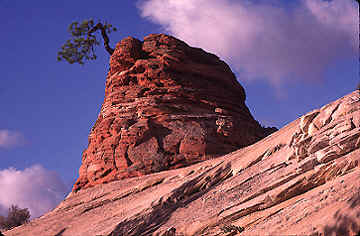|
Mukuntuweap National Monument proclaimed July 31, 1909, incorporated in Zion National Monument by proclamation March 18, 1918.
Established as national park Nov. 19, 1919. Separate Zion National Monument proclaimed Jan. 22, 1937, incorporated in park July 11, 1956.
Other boundary changes:
June 13, 1930; June 3, 1941; Feb. 20, 1960; Oct. 21, 1976.
LAND
AREA: 146,597.64 acres;
Federal: 143,040.40;
Nonfederal: 3,557.24.
NUMBER
OF VISITORS PER YEAR:
Approximately 2.5 million.
Significance
Established to preserve and protect aesthetic and
scientific values:
Zion
features stunning scenery
found nowhere else on earth.
Zion
is a geologic showpiece
with sandstone cliffs among the highest in the
world.
Zion
features
one of the last mostly free-flowing river systems on
the Colorado Plateau.
Zion
features
a large, diverse plant and animal community.
Zion
features
evidence of human occupation both historic and
prehistoric, including excellent examples of
Civilian Conservation Corps work.
Elevation
Lowest 3,666 ft (1,128 m), Coalpits Wash in the
southwest corner. Highest 8,726 ft (2,660 m), Horse
Ranch Mountain in the Kolob Canyons section.
Precipitation
Average 15 inches.
Name
Zion, a Hebrew word referring to a place of safety
or refuge, given to this canyon by Mormon pioneers
in the 1860s.
Kolob
in Mormon theology, is a heavenly place close to
God.
Plant
Life
Richest diversity of plants in Utah--almost 800
native species. Differences in elevation, sunlight,
water, and temperature create ''microenvironments,''
like hanging gardens, forested side canyons, and
isolated mesas that lend to this diversity.
Animal
Life
75 species of mammals, 271 birds, 32 reptiles and
amphibians, 8 fish. Commonly seen animals include
mule deer, rock squirrels, lizards, and many species
of birds. Rare or endangered species include the
Peregrine Falcon, Mexican Spotted Owl, Southwest
Willow Flycatcher, desert tortoise, and the Zion
snail, found nowhere else on earth.
Human
History
Evidence of Ancestral Puebloans, formerly known as
the Anasazi, date from about 2,000 years ago;
Paiutes from about 800 years ago to present. Mormon
settlers arrived in the 1860s. Park visitation in
1920 was 3,692; in 1996 it reached 2.5 million.
|


![]()
